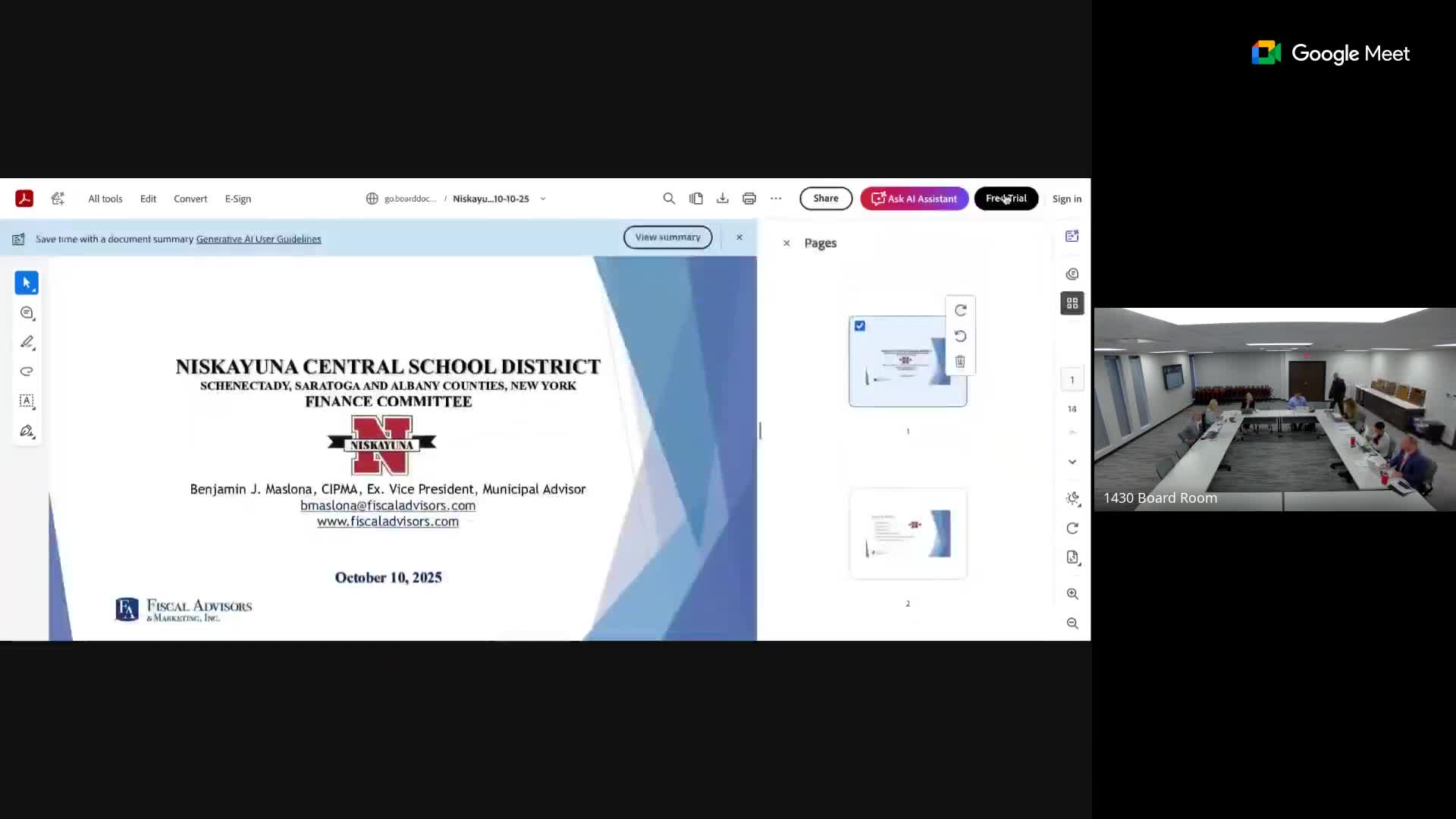District weighs DASNY financing, rebates and reserves as it plans possible $50M 2027 project
October 10, 2025 | NISKAYUNA CENTRAL SCHOOL DISTRICT, School Districts, New York
This article was created by AI summarizing key points discussed. AI makes mistakes, so for full details and context, please refer to the video of the full meeting. Please report any errors so we can fix them. Report an error »

Ben Pascolona of Fiscal Advisors told the Audit & Finance Committee on Oct. 10 that recent financings and state building-aid rules will shape any 2027 capital project and the district’s tax impact.
Pascolona reviewed the 2021 and 2024 projects, noting the district has borrowed against the full $79 million 2021 authorization and that bond anticipation notes (BANs) of about $35.9 million remain outstanding; roughly $25.9 million of those BANs are attributable to the 2021 project. He said the district’s capital reserve is “just under $8 million,” and that energy rebates tied to recent heat-pump replacements have provided additional local resources—about $490,000 received and roughly $400,000 more projected from utility rebate programs.
Pascolona described how building aid is tied to State Education Department (SED) project numbers and a calculated assumed interest rate. He said using the Dormitory Authority of the State of New York (DASNY) to finance certain borrowings produced additional building-aid benefit versus open-market debt in recent years; the DASNY approach increased estimated building aid by several hundred thousand dollars in 2024–25 and 2025–26, which Pascolona said increased the 15-year aid benefit by roughly $4.8 million in one recent analysis.
Using SED capacity and cost-allowance rules, Pascolona showed a high-school example in which the state’s construction and incidental-cost ceilings determine how much of a building’s scope is eligible for aid. He cautioned that prior projects consume part of a building’s five-year allowance and that timing affects whether work is aided. He told the committee that, based on current assumptions and maintaining a stable local capital levy, a $50 million 2027 project could be structured so the overall local capital-tax levy remains at roughly the same level once projects are fully layered in. Pascolona emphasised that estimates will change when scope and SED project numbers are finalized.
Pascolona also reviewed shorter-term financing plans: the district issued a $10 million BAN in June 2025 and plans a short-term financing in June 2026 that will mature in June 2027 to match construction cash flow. He said the district plans to sell a five-year bus bond in November; he noted the state shortened aidable life for electric-vehicle buses from 12 to eight years, while conventional buses remain amortized over five years, which affects annual budget planning.
The committee discussed next steps: awarding a five-year building-condition survey to a vendor (the board will act on a King & King proposal on Tuesday), issuing an RFP for enrollment projections (award planned for Nov. 18 and initial projections expected Feb.–Mar. next year), and continuing the capital-planning work for a possible 2027 referendum. Pascolona and district staff said options remain and final scope, aid percentages and timing will drive any formal recommendation to the board.
Pascolona reviewed the 2021 and 2024 projects, noting the district has borrowed against the full $79 million 2021 authorization and that bond anticipation notes (BANs) of about $35.9 million remain outstanding; roughly $25.9 million of those BANs are attributable to the 2021 project. He said the district’s capital reserve is “just under $8 million,” and that energy rebates tied to recent heat-pump replacements have provided additional local resources—about $490,000 received and roughly $400,000 more projected from utility rebate programs.
Pascolona described how building aid is tied to State Education Department (SED) project numbers and a calculated assumed interest rate. He said using the Dormitory Authority of the State of New York (DASNY) to finance certain borrowings produced additional building-aid benefit versus open-market debt in recent years; the DASNY approach increased estimated building aid by several hundred thousand dollars in 2024–25 and 2025–26, which Pascolona said increased the 15-year aid benefit by roughly $4.8 million in one recent analysis.
Using SED capacity and cost-allowance rules, Pascolona showed a high-school example in which the state’s construction and incidental-cost ceilings determine how much of a building’s scope is eligible for aid. He cautioned that prior projects consume part of a building’s five-year allowance and that timing affects whether work is aided. He told the committee that, based on current assumptions and maintaining a stable local capital levy, a $50 million 2027 project could be structured so the overall local capital-tax levy remains at roughly the same level once projects are fully layered in. Pascolona emphasised that estimates will change when scope and SED project numbers are finalized.
Pascolona also reviewed shorter-term financing plans: the district issued a $10 million BAN in June 2025 and plans a short-term financing in June 2026 that will mature in June 2027 to match construction cash flow. He said the district plans to sell a five-year bus bond in November; he noted the state shortened aidable life for electric-vehicle buses from 12 to eight years, while conventional buses remain amortized over five years, which affects annual budget planning.
The committee discussed next steps: awarding a five-year building-condition survey to a vendor (the board will act on a King & King proposal on Tuesday), issuing an RFP for enrollment projections (award planned for Nov. 18 and initial projections expected Feb.–Mar. next year), and continuing the capital-planning work for a possible 2027 referendum. Pascolona and district staff said options remain and final scope, aid percentages and timing will drive any formal recommendation to the board.
View the Full Meeting & All Its Details
This article offers just a summary. Unlock complete video, transcripts, and insights as a Founder Member.
✓
Watch full, unedited meeting videos
✓
Search every word spoken in unlimited transcripts
✓
AI summaries & real-time alerts (all government levels)
✓
Permanent access to expanding government content
30-day money-back guarantee

